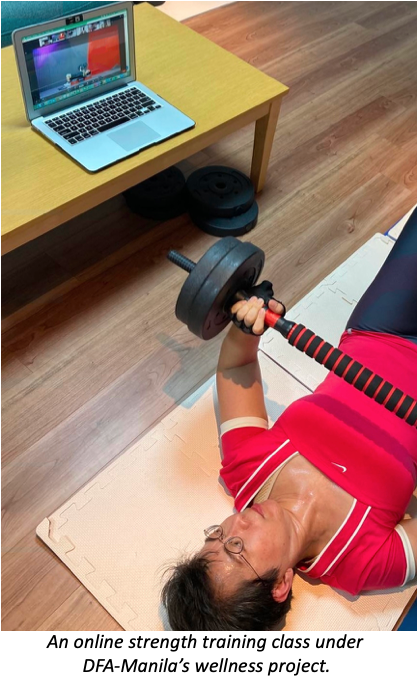Nagoyaka Gaiko: “Strength Training for the Mind and Body”
by Philippine Consul General Celeste Vinzon-Balatbat
17 July 2022, Chunichi Shimbun
 All my life, I have not been athletic. I would rather watch the others play sports.
All my life, I have not been athletic. I would rather watch the others play sports.It was a big enough step for me to join my husband in enrolling at a gym in 2009.
After a few months, just as I had been able to make gym time a part of my regular routine, one of the instructors replaced her core training classes with weight training. I was dismayed. It would be the only group exercise class available during my preferred time slot, and I was not keen on the alternative: using the gym equipment by myself.
Sign up, I did. The workout consisted of choreographed, repetitive movements that would target major muscle groups. We chose our weights for each track, based on our own capacity, level of comfort, and desired results.
Our instructor, whose petite frame belied her strength, coached and guided us through the routine, emphasizing the proper posture, position, and technique.
Upbeat music provided the tempo to our movements and made the class more fun.
While the barbells initially looked intimidating, the class was a safe space. Most of my gym classmates—a group of friendly, fierce, and fabulous mothers and aunties—were newbies to weight training too, and we gave each other encouragement.
We fed off the infectious energy from the instructor and our fellow students. Since we were all going through the same routine, we felt a sense of solidarity in surviving the workout session.
As we groaned, grimaced, and groused during class, camaraderie, water, willpower, and wellness goals kept us going past our agony.
To minimize the risk of injury, we were reminded to “listen” to our body, recognize the difference between muscle soreness and muscle pain, and handle the weights properly. No multitasking, no distractions, with the mind focusing on the muscles, the movements, and the music.
The Mind-and-Body Connection. Strength training has proven to be empowering and—with the right coach—truly motivating. While it helps strengthen one’s body, it also develops endurance, self-discipline, focus, and positivity.
It has been liberating: I have shed the old mindset about strength training being only for the men, the young, the athletic. I do not need to fit the mold—any mold. I can be as strong as my mind tells me I am. As Mahatma Gandhi has said, “Strength does not come from physical capacity. It comes from an indomitable will.”
It teaches patience: Results are not always evident, nor do they happen overnight and through forced intensity. They require time, consistency, persistence, and synergy with nutritious food choices, enough rest, and other lifestyle changes.
Even as my wellness journey hits a snag every now and then (e.g., the physical challenges that come with the passing of the years), I can simply accept the setbacks and, like the athletes I admire, keep trying. While I struggle and get breathless finishing the routine, I derive satisfaction from knowing that I am taking care of my health—and enjoying the process.
I shall eventually return to the gentler workouts of my past. For now, I’m getting my endorphin fix at home, through my barbell and online class.
A shorter version of this article in Nihonggo can be accessed at the Chunichi Shimbun through the following link:

